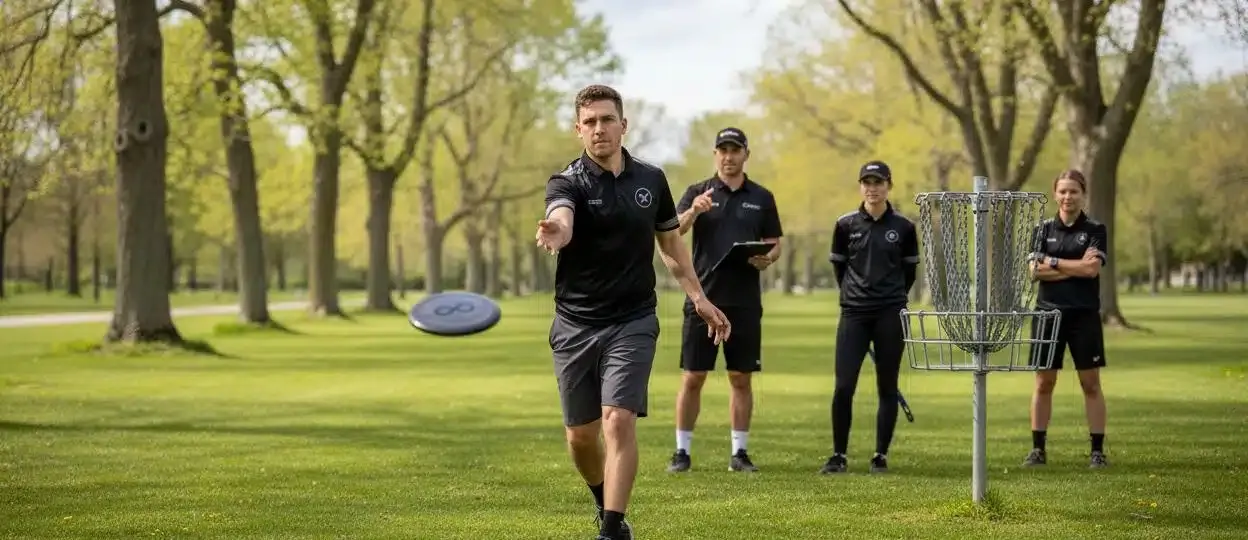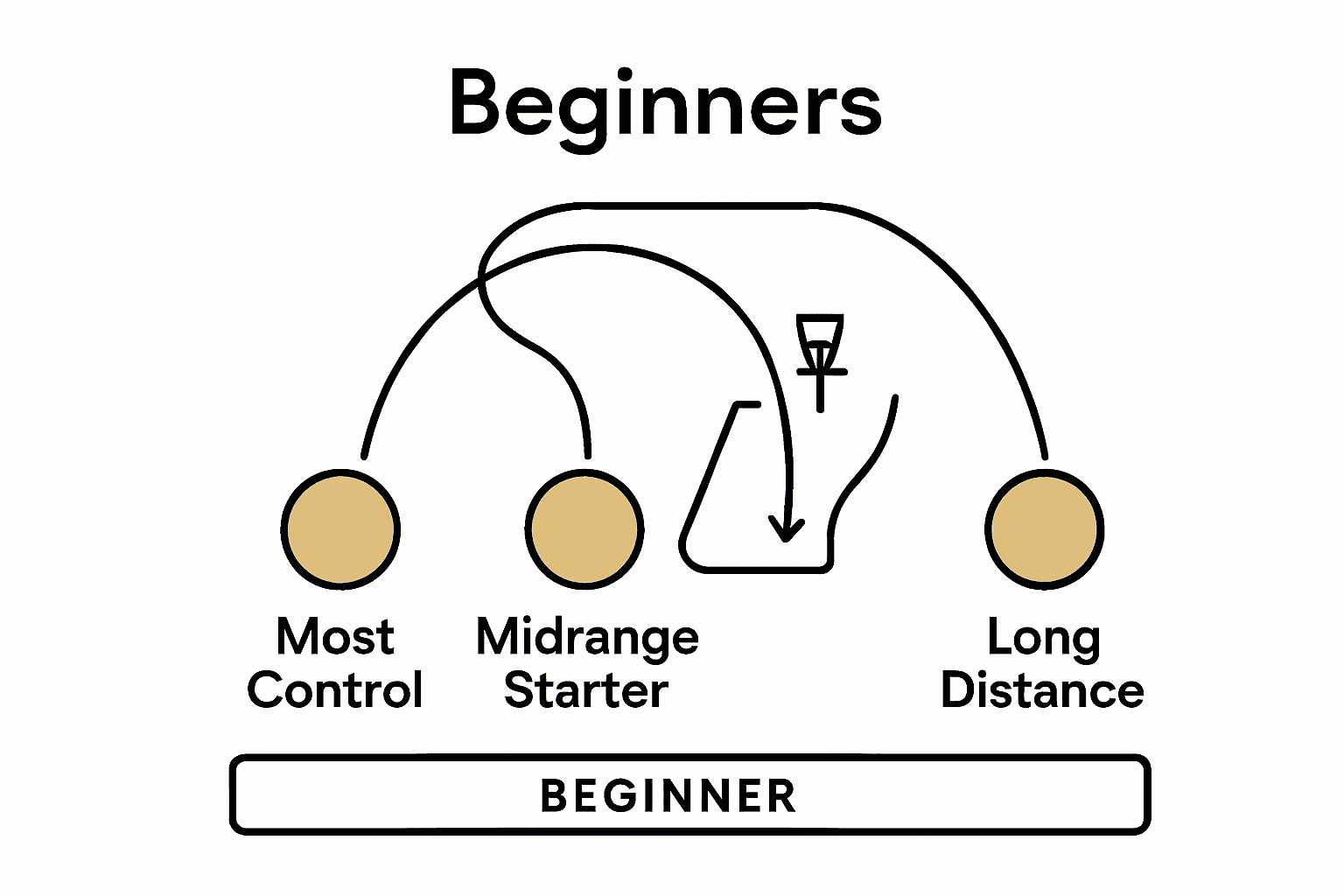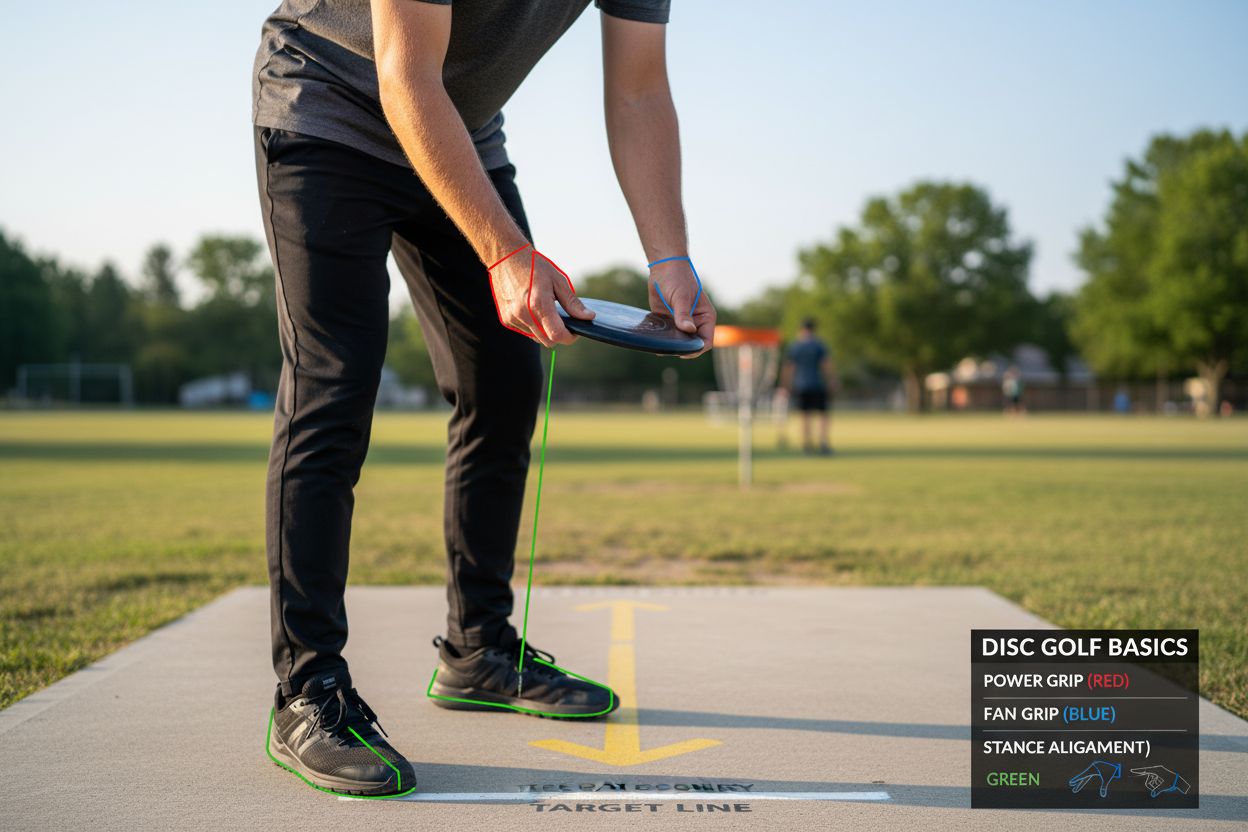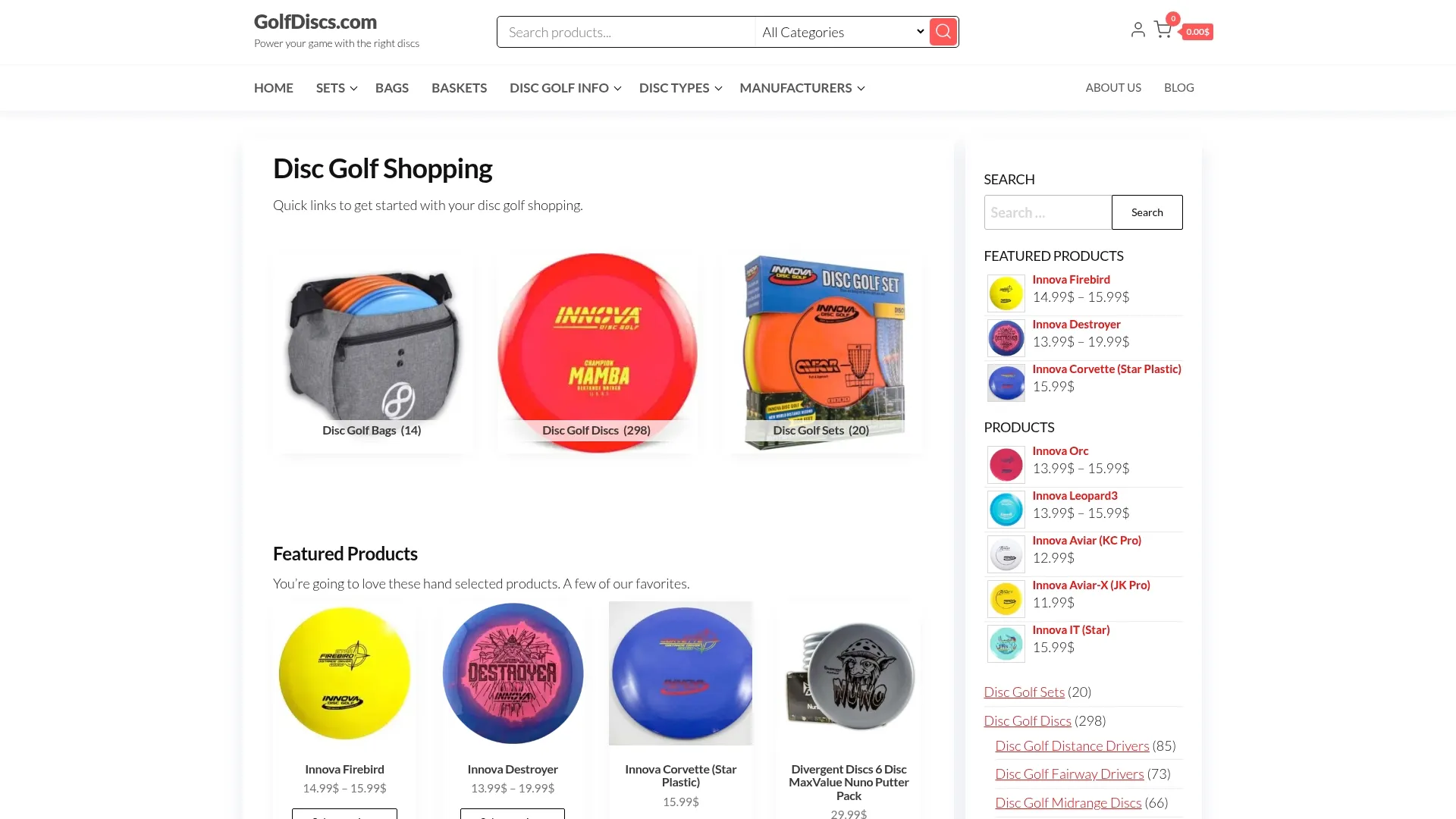
How to Improve Accuracy in Disc Golf: Step-by-Step Guide
Did you know that over three million people now play disc golf worldwide? As the sport grows, beginners often feel overwhelmed by all the advice on improving accuracy. Finding the right technique quickly sets you apart on the course. Whether you want tighter aim or better consistency, mastering a few simple steps can make every throw more rewarding and much more fun.
Quick Summary
| Key Point | Explanation |
|---|---|
| 1. Choose low-speed, high-glide discs | Beginners should start with low-speed discs that offer stability and predictability for greater control and confidence in throws. |
| 2. Focus on grip and stance techniques | Mastering proper grip styles and a balanced stance is essential for developing accurate and consistent throws in disc golf. |
| 3. Practice consistent throwing motions | Slow down your throwing for better timing and practice specific movements to build muscle memory and enhance throwing precision. |
| 4. Analyze and adjust your throws | Observe your throw outcomes to identify patterns, allowing you to make micro-adjustments that improve your overall technique. |
| 5. Track progress and set small goals | Regularly monitor your performance metrics to celebrate improvements and maintain motivation on your journey to becoming a skilled disc golfer. |
Table of Contents
- Step 1: Choose The Right Disc For Your Throw
- Step 2: Master Basic Grip And Stance Techniques
- Step 3: Practice Consistent Throwing Motions
- Step 4: Analyze Your Throws And Adjust Technique
- Step 5: Track Progress And Celebrate Your Gains
Step 1: Choose the Right Disc for Your Throw
In this critical step, you will learn how to select the perfect disc that matches your throwing style and skill level. Choosing the right disc can dramatically improve your accuracy and overall performance on the disc golf course.
As a beginner, your primary focus should be on control and building confidence. According to disc golf experts, low-speed discs with high glide and minimal fade are ideal for newcomers. Start with putters and midrange discs that provide predictable flight paths and help you develop proper throwing mechanics.
When selecting your initial discs, pay attention to weight and stability. Heavier discs around 165-175 grams offer more stability and perform better in windy conditions. For your first discs, look for overstable models that resist turning and provide consistent flight patterns. This means the disc will naturally want to fade left (for right-handed backhand throws) and create more predictable trajectories.
Pro Tip: Test multiple discs before committing. Every player has a unique throwing style, so what works for one person might not work perfectly for another.
Consider visiting a local disc golf shop or checking out our guide on disc types to get hands-on experience with different disc selections. Most shops will let you handle and even practice throws with sample discs.
As you progress, you will gradually expand your disc collection to include drivers and more specialized throwing discs. But for now, focus on mastering control with beginner-friendly midrange and putter discs. Your accuracy will improve significantly with consistent practice and the right equipment.

Here’s a comparison of popular beginner disc types:
| Disc Type | Flight Path | Ideal Skill Level | Main Benefit |
|---|---|---|---|
| Putter | Straight, minimal fade | Beginner | Maximum control |
| Midrange | Slight curve, predictable | Beginner | Versatile, easy to learn |
| Fairway Driver | Gentle curve, some fade | Intermediate | Longer distance, moderate control |
| Distance Driver | Sharp curve, strong fade | Advanced | Maximum distance |
In the next step, we will explore the fundamental throwing techniques that will help you maximize the potential of your newly selected discs.
Step 2: Master Basic Grip and Stance Techniques
In this step, you will learn the fundamental techniques that transform an average throw into a precise and powerful disc golf shot. Mastering your grip and stance are the cornerstones of developing consistent and accurate throws.
According to disc golf technique experts, a balanced grip is crucial for control and release quality. Hold the disc firmly but not with a death grip. Your thumb should rest on top of the disc, while your fingers provide supportive underneath placement. Think of it like holding a delicate object you do not want to crush but also do not want to drop.
When it comes to grip styles, you have two primary options. The power grip works best for drives and long-distance throws where you want maximum velocity. Place all four fingers along the rim of the disc, creating a tight seal. For shorter shots or midrange throws, the fan grip provides more control. Here, your fingers are spread out slightly on the disc, offering more touch and precision.
Pro Tip: Practice your grip without throwing. Muscle memory develops through repetition, so spend time holding and repositioning your disc to find your most comfortable technique.
Stance is equally important. A balanced stance establishes a stable base crucial for accuracy. Position your feet shoulder-width apart, with your body facing slightly sideways to your target. Your weight should start on your back foot and transfer smoothly to your front foot during the throwing motion. Align your front foot toward your target to create a natural throwing path.
As you prepare to throw, keep your body relaxed but engaged. Tension kills smooth motion. Imagine a slight athletic stance like a baseball pitcher or basketball player preparing to shoot. Your body should feel ready to move, not rigidly locked in place.

Learn more about throwing techniques in our comprehensive backhand guide to refine your skills further. In the next step, we will break down the actual throwing mechanics that will help you translate these foundational grip and stance techniques into accurate disc flight.
Step 3: Practice Consistent Throwing Motions
In this crucial step, you will transform your throwing technique from random attempts to a repeatable, precise motion that builds muscle memory and improves overall disc golf accuracy. Consistency is the secret weapon of great disc golfers.
Slow down your throwing motion to develop better timing and release control. Professional disc golfers recommend breaking down your throw into smaller segments and practicing each movement deliberately. Think of it like learning a dance move—you start slowly, focusing on each step until the entire sequence becomes smooth and natural.
Focus intensely on your plant foot placement. This is the foundation of a consistent throw. Your plant foot should land in the same spot and angle with each throw, creating a reliable launch platform. Videotape yourself or ask a friend to watch your footwork. Look for subtle variations that might disrupt your throwing rhythm.
According to disc golf technique experts, aligning your shoulders and hips parallel to your target line is critical. Imagine a straight line extending from your back foot through your body toward your target. Your entire kinetic chain should move along this line, creating a synchronized motion that transfers power efficiently.
Pro Tip: Practice without a disc first. Go through your throwing motions in slow motion, focusing on smooth weight transfer and body alignment.
Learn advanced throwing techniques in our forehand technique guide to further refine your skills. Repetition is your greatest teacher.
Set up a practice area where you can throw multiple times and track your muscle memory development.
Remember that building consistency takes time. Some days will feel frustrating, but stay patient. In the next step, we will explore how to analyze and adjust your throwing technique to continually improve your accuracy.
Step 4: Analyze Your Throws and Adjust Technique
In this critical step, you will transform your disc golf performance by becoming a strategic observer of your own throwing technique. Learning to analyze and adapt your throws is the difference between being a casual player and developing true disc golf skill.
Practice stand-still and scramble shots to understand how discs behave under different conditions. Each throw is a learning opportunity. When you commit fully to a shot, pay close attention to how your disc responds to terrain, wind, and your release angle. Did it curve more than expected? Did it fade earlier or later than anticipated? These observations are gold for improving your technique.
Start by creating a simple tracking system. Use a notebook or your smartphone to record throw details. Note the disc type, wind conditions, your body position, and the throw’s outcome. Over time, patterns will emerge that reveal your strengths and areas needing improvement. Maybe you consistently throw slightly right or struggle with headwinds. Recognizing these patterns is the first step to correction.
Learn how to improve your hand speed for more consistent throws which can dramatically impact your accuracy. The more you understand your personal throwing mechanics, the more precisely you can make micro adjustments.
Pro Tip: Record video of your throws from multiple angles. Watching yourself can reveal technical flaws invisible during the actual throw.
Consider practicing in varied environments. A throw that works perfectly in an open field might behave differently in a wooded course with obstacles. Expose yourself to different terrains and challenges. Each new scenario teaches you something about disc flight and your personal technique.
Remember that improvement is a journey of patience and observation. In the next step, we will explore advanced techniques for fine-tuning your disc golf accuracy and developing a more intuitive throwing style.
Step 5: Track Progress and Celebrate Your Gains
In this final step, you will learn how to transform your disc golf journey from random practice to a structured path of continuous improvement. Tracking your progress is not just about numbers—it is about recognizing and celebrating your personal growth as a disc golfer.
Apps like Disc Golf Journal provide incredible tools for logging practice and tracking performance. These digital companions allow you to record not just scores, but specific technique details, video clips of your throws, and performance metrics. Think of it as creating a personal disc golf diary that tells the story of your skill development.
Objective measurement matters. The UDisc app offers data-driven player ratings based on millions of recorded rounds, which helps you understand your performance within a broader context. These ratings adjust for course difficulty, giving you a more accurate picture of your true skill level. Do not get discouraged by initial ratings—they are a starting point, not a final judgment.
Pro Tip: Set incremental goals. Instead of aiming to become a professional overnight, focus on small improvements like reducing your average throws per hole or improving your accuracy on specific types of shots.
Create a progress tracking system that motivates you. Maybe it is a simple spreadsheet, a dedicated notebook, or a digital app. Record not just your scores, but moments of personal triumph. Did you successfully execute a challenging throw? Note it. Did you improve your form on a particular shot? Celebrate that win.
Remember that progress is not linear. Some weeks you will see dramatic improvements, other weeks might feel stagnant. Stay patient and consistent. Your dedication to tracking and understanding your journey will pay off in steady, sustainable skill development.
Ready to Sharpen Your Disc Golf Accuracy?
You have just learned the steps to help improve your aim, from selecting the perfect disc to tracking your own progress. But frustration can still strike when your equipment does not support your growth or your discs do not fly as predictably as you practiced. If you want to see real gains in your disc golf accuracy, you need the right discs matched to your throwing style and skill level, not to mention expert resources to guide you on your journey.

Unlock better control today and see a difference in your scores. Visit Golf Discs to discover our range of beginner-friendly and professional disc golf discs as well as up-to-date throwing guides such as Understanding Disc Golf Types and How to Throw Backhand. Take the guesswork out of your next practice round and shop now for gear that helps you hit your targets with confidence.
Frequently Asked Questions
How can I choose the right disc to improve accuracy in disc golf?
Choosing the right disc is essential for accuracy. Start with low-speed putters and midrange discs for control and predictable flight paths. Test multiple discs to find one that complements your throwing style and skill level.
What grip technique should I use to enhance my throwing accuracy?
A balanced grip is crucial for throwing accuracy. Use a power grip for distance throws by placing all four fingers along the rim or try a fan grip for more control on shorter shots. Practice your grip regularly to develop muscle memory.
How can I analyze my throws to make adjustments in my technique?
To analyze your throws effectively, track key details such as disc type, wind conditions, and throw outcomes. Keep a log to identify patterns in your performance, which will help you pinpoint areas for improvement. Consider recording video of your throws for visual feedback.
What are some effective ways to practice my throwing motions?
Slow down your throwing motions during practice to build consistency. Break your throw down into smaller segments and focus on perfecting each step before adding speed. Aim for a reliable plant foot placement and body alignment with your target on each throw.
How can I track my progress and celebrate improvements in disc golf?
Tracking your progress involves recording your practice sessions and noting improvements in your technique and scores. Create a simple system to document significant achievements, like executing difficult throws. Set incremental goals to motivate yourself and stay focused on continuous improvement.
What basic stance should I adopt to improve my disc golf accuracy?
A balanced, shoulder-width stance helps establish a stable base for accurate throws. Position your body slightly sideways to your target and ensure your weight transitions smoothly from your back foot to your front foot during the throw. Rehearse this stance without a disc to solidify muscle memory.
